Folia Theologica et Canonica 6. 28/20 (2017)
IUS CANONICUM - Szabolcs Anzelm Szuromi, O.Praem., An overview on the international relations of the Holy See since the ‘Roman question' until 1967, correlated with the first codification (1917)
116 SZABOLCS ANZELM SZUROMI, O.PRAEM. These reviewed two documents properly characterize the peculiarity of concordat’s form. At the same time the German concordat enlightens which kind of changes the official German politics went through in the judgment of freedom of the Church and religion, which among other things let to the Mit brennender Sorge Encyclical Letter of Pope Pius XI, published on March 14lh 1937, condemning totalitarianism and racial theory.69 If we compare the already described international agreements to the text of the new Austrian concordat - still under the force of the CIC (1917) - assembled after one and half decade following the World War II, the thematic changes are obvious. Ten articles of the document signed by apostolic nuncio Giovanni Delaine, Bruno Kreisky, and Heinrich Drimmel on June 23rd 1960 - still before the new Apostolic Constitution Regimini Ecclesiae Universae (August 15lh 1967) by Pope Blessed Paul VI - modified the agreement which was settled between the parties in 1933.70 The new one - because the essential alteration of circumstances - basically was dedicated to the financial support of the Church. This concordat intended to provide adequate financial base to functioning of the Catholic Church. In order to reach this aim. the Austrian State pledges the Catholic Church a one-time grant of 50 million Schillings.71 The parties concluded that the administration of the Church properties in Austria had to be under the current Austrian state law.72 The document regulated furthermore the situation of the ecclesiastical juridical and natural persons, the estate of the Archdiocese of Salzburg73, and the income of the Apostolic Administration of Burgenland.74 Collection of tithing had to be done by the Church herself based on the concordat, nevertheless, Austria acknowledged that as a civil claim securing a possible collection through the civil court proceeding.75 It needs to be added that the same day (June 23rd 1960) and between the same parties, it came to the signing of a bilateral agreement in 9 Articles in regard to the functioning of the Apostolic Administration of Burgenland. which regulated the position of the Diocese of Eisenstadt.76 The Diocese of Eisenstadt belonged to Burgenland by territory; however, it belonged to the Archdiocese of Vienna within the ecclesiastical administrative system. The agreement mentioned the legal status of the Apostolic Administration, and 69 Pius XI, Litt. Enc. Mit brennender Sorge ( 14 mart. 1937): AAS 29 (1937) 145-167. 70 Signed on June 23,d 1960; ratified on August 22“' 1960: ATS 52 (1960) 933-945. Cf. Martin de Agar, J. T. (ed.), Raccolta eli concordati. 1950-1999 (Collectio Vaticana 3), Città del Vaticano 2000. 52-63. 71 Art. Il/a: Martín de Agar, J. T. (ed.), Raccolta di concordati, 53. 72 Art. Ili: Martin de Agar, J. T. (ed.), Raccolta di concordati, 54. 73 Arts. IV-V: Martin de Agar, J. T. (ed.), Raccolta di concordati, 55-56. 74 Art. VI: Martin de Agar. J. T. (ed.), Raccolta di concordati, 56-57. 75 Art. VII: Martín de Agar, J. T. (ed.). Raccolta di concordati, 57-58. 76 Martín de Agar, J. T. (ed.), Raccolta di concordati, 60-63.
